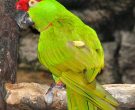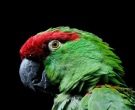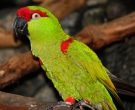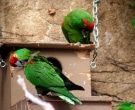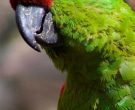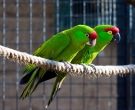Content |
|---|
Description:
38 cm.. of length and a weight of 300 g..
The Thick-billed Parrot (Rhynchopsitta pachyrhyncha) has the forecrown, the lores and a large swath in the region supercilii, bright Scarlet Red; a small patch of feathers brown in color lores, directly in front of the eyes; the crown, the cheeks and the sides of the neck are green with yellow tinge. The upperparts Green tinged indistinct tone olive in scapulars.
Upperwing-coverts Green with red feathers in the region where bend the wings. The flight feather of color green for over, with blackish tips and margins to the vane inner, grey below. Large infra-wing coverts Yellow, other coverts green.
Underparts Green with red on the the thighs. Upper, the tail green; gray at the bottom.
The bill black; bare orbital skin yellowish white; irises yellow-orange; legs grey.
Both sexes similar.
Immature with the bill color horn, greyish the bare orbital skin, and no Scarlet feathers behind the eye or red in the region where bend the wings.
The Thick-billed Parrot is often treated as the same species as the Maroon-fronted Parrot.
- Sound of the Thick-billed Parrot.
Habitat:
It inhabits in Highlands with mature pine forests or pine forests with other conifers of the genus Pseudotsuga, malls Populus and/or trees of the genus Quercus, in areas isolated and often rugged, sometimes are also observed in towns of lowlands.
They are mostly distributed at altitudes between 1,500 and 3,000 m, breeding generally at heights between 2,000 and 3,000 m.
Its preference they are areas with Pinus arizonica and Pinus ayacahuite. In general, observed in flocks. They rest in large groups on inaccessible cliffs or trees with dense foliage. Diurnal movements of up 40 km between resting areas and feeding.
Long-lived and gregarious, they form social groups; because of this, over time the Thick-billed Parrot they return to visit forests which are of your choice.
Reproduction:
Nest in the cavities of trees, usually pine, but also, according to sources, in trees of the species Populus tremuloides and Pseudotsuga taxifolia; usually in trees partially dead or alive, with small holes excavated, for example, by woodpeckers as the Northern Flicker (Colaptes auratus) or caused by fungal decomposition in the Heartwood wood; sometimes very together (in the same tree) When there is available room, Although generally scattered.
The breeding season coincides with the ripening of the pine seeds; birds, usually, They arrive at the breeding area between the months of April and May, carrying out the mid June to end of July update. The young begin to leave the nest from early September to late October, after 59 – 65 days, depending on their parents for a period of time after fledging.
Clutch of 2 to 4 eggs, generally three, Perhaps variable with the size of the harvest of pine seeds. The care of the eggs during incubation is carried out by the female and the care of the young is biparental..
Food:
Diet Thick-billed Parrot It is mainly composed of pine seeds (including the of the Pinus teocote and of the Pinus leiophylla) extracted from the cones with its powerful beak; They also feed, according to sources, of seeds and sprouts coniferous Pseudotsuga, fruits of the American black cherry (Prunus serotina) and acorns.
Distribution:
Size of the area of distribution (reproduction / resident): 67.100 km2
The distribution Master of the Thick-billed Parrot lies between the West and centre of Mexico, with sporadic movements towards the North and towards South.
You can see in Sierra Madre Occidental in the South of Chihuahua, South and West of Durango, the adjacent areas of the East of Sonora and Sinaloa; confirmed breeding only in the first two states.
Like other bird specialists in pine seeds, the Thick-billed Parrot wanders widely after playback, sporadically to South-West of Mexico in Jalisco, Colima and Michoacán, previously to the East up to Veracruz (Although these records are possibly involved the Maroon-fronted Parrot – Rhynchopsitta in terris) and, possibly, Coahuila de Zaragoza.
Formerly it was a sporadic visitor, and possibly resided and lesson in Arizona (especially in the mountains of Chiricahua, in the South) and in New Mexico, EE.UU, Although since the beginning of the century 20 no large-scale visits have been observed and the latest reproductive data in the area date from the 1938.
The presence of the Thick-billed Parrot is determined by the availability of pine seeds; the core of your playback area It seems to be the most constantly occupied area.
The decrease important in your population during the century 20 as a result ,mainly, of the loss and degradation of habitat, with the absence of these birds where the large pines were cut down, mainly by forestry. The loss of birds in EE.UU. was attributable to the hunt, but his presence there, probably, It was only in the short term, When were feeding conditions unusually favorable (or on the contrary very unfavorable in Mexico).
The recent threats in Mexico they are the trade in live birds and the continuous loss of habitat for livestock, as well as logging (the loss of old trees for nesting is a major problem that puts this species at a higher risk than the of the Maroon-fronted Parrot, when the latter uses the cliffs to build their nests).
Confiscated and captive-bred birds were released in Arizona at the end of the Decade of 1960, with the first successful reproduction in EE.UU. shortly after, although unfortunately the birds have mostly disappeared from that area.
There are no protected areas in Sierra Madre Occidental. The Appendix I. In danger.
Conservation:
State of conservation ⓘ |
||
|---|---|---|
 Endangered ⓘ (UICN)ⓘ
Endangered ⓘ (UICN)ⓘ
| ||
• Red List category of the UICN current: In danger of extinction
• Population trend: Decreasing
The thick-billed Parrot is found in danger of extinction due to the destruction of nesting habitat, as well as his commercial exploitation, the decrease of population who have suffered these parrots is very evident to those that, long overdue, They inhabit the timber areas of Chihuahua and Durango (Lanning and Shiflett, 1981).
The commercial logging of pine living for wood, as well as standing dead trees to obtain their pulp, they are ending with a lot of nesting sites effective and potential for these birds (Lanning and Shiflett, 1983).
The trade of the parrots seemed to be minimal until the 1980s (Lanning and Shiflett, 1981), However, It is estimated that during 1985 and 1986 between several hundred and even thousands of parrots were illegally trafficked to the United States of America (Snyder & Wallace, 1988).
To reduce these threats the species and its habitat, There are legal instruments such as the vedas and provisions in the Law-General ecological balance and environmental protection (LGEEPA) and General wildlife law (LGVS); as well as the Norma Oficial Mexicana NOM-059-SEMARNAT-2001 that lists the species of Mexican wild flora and fauna under some risk category and the inclusion and modification mechanisms.
The size of the population of the Thick-billed Parrot It is estimated between 2000-2800 mature individuals.
"Thick-billed Parrot" in captivity:
Its sale as a pet is illegal.
Alternative names:
– Thick-billed Macawlet, Thick billed Parrot, Thick-billed Parrot (English).
– Conure à gros bec, Perriche à gros bec, Perruche à gros bec (French).
– Kiefernsittich, Arasittich, Kiefern Sittich (German).
– Papagaio-mexicano-de-testa-vermelha (Portuguese).
– Cotorra de Pico Ancho, Cotorra serrana, Cotorra Serrana Occidental, Cotorra-serrana Occidental (español).
– Cotorra serrana, Cotorra-serrana Occidental, Loro de Pico Grueso Occidental Mexicano, Cotorra de Pico Duro,
Guacamaya, Guaca (Mexico).
scientific classification:
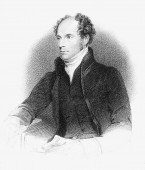
– Order: Psittaciformes
– Family: Psittacidae
– Genus: Rhynchopsitta
– Scientific name: Rhynchopsitta pachyrhyncha
– Citation: (Swainson, 1827)
– Protonimo: Macrocercus pachyrhynchus
Thick-billed Parrot images:
Thick-billed Parrot (Rhynchopsitta pachyrhyncha)
Sources:
– Avibase
– Parrots of the World – Forshaw Joseph M
– Parrots A Guide to the Parrots of the World – Tony Juniper & Mike Parr
– Birdlife
– National Commission of Natural Protected Areas
– Photos:
(1) – Two Thick-billed Parrots at Arizona-Sonora Desert Museum, Tucson, Arizona, USA By Tim Lenz from Ithaca (Thick-billed ParrotsUploaded by Snowmanradio) [CC BY 2.0], via Wikimedia Commons
(2) – Thick-Billed Parrots at Twycross Zoo, Leicestershire, England By derivative work: Snowmanradio (talk)Rhynchopsitta_pachyrhyncha_-Twycross_Zoo-8.jpg: Paul Reynolds from UK [CC BY 2.0 or CC BY 2.0], via Wikimedia Commons
(3) – An adult Thick-billed Parrot at Edinburgh Zoo, Scotland By Jenni Douglas from Edinburgh, Scotland (Thick billed ParrotUploaded by Snowmanradio) [CC BY 2.0], via Wikimedia Commons
(4) – A Thick-billed Parrot at Cincinnati Zoo, USA By Rhynchopsitta_pachyrhyncha_-captive-8a.jpg: Jean from Shelbyville, KYderivative work: Snowmanradio [CC BY 2.0], via Wikimedia Commons
(5) – Three adult Thick-billed Parrots in captivity in the USA By Joe Mazzola (LovebirdsUploaded by snowmanradio) [CC BY-SA 2.0], via Wikimedia Commons
(6) – Thick-billed Parrot (Rhynchopsitta pachyrhyncha). Two parrots on a nestbox By Just chaos [CC BY 2.0], via Wikimedia Commons
(7) – Thick-billed Parrot Rhynchopsitta pachyrhyncha at Cincinnati Zoo By Ltshears (Own work) [CC BY-SA 3.0 or GFDL], via Wikimedia Commons
(8) – A Thick-billed Parrot in captivity By Mark Dumont from Cincinnati, USA (Thick Billed ParrotUploaded by snowmanradio) [CC BY 2.0], via Wikimedia Commons
(9) – Thick-billed Parrot – Rhynchopsitta pachyrhyncha at Cincinnati Zoo By Ltshears (Own work) [CC BY 3.0], via Wikimedia Commons
(10) – Monographia Psittacorum By Wagler, Johann Georg [CC BY 2.0 or Public domain], via Wikimedia Commons
– Sounds: Scott Olmstead (Xeno-canto)


